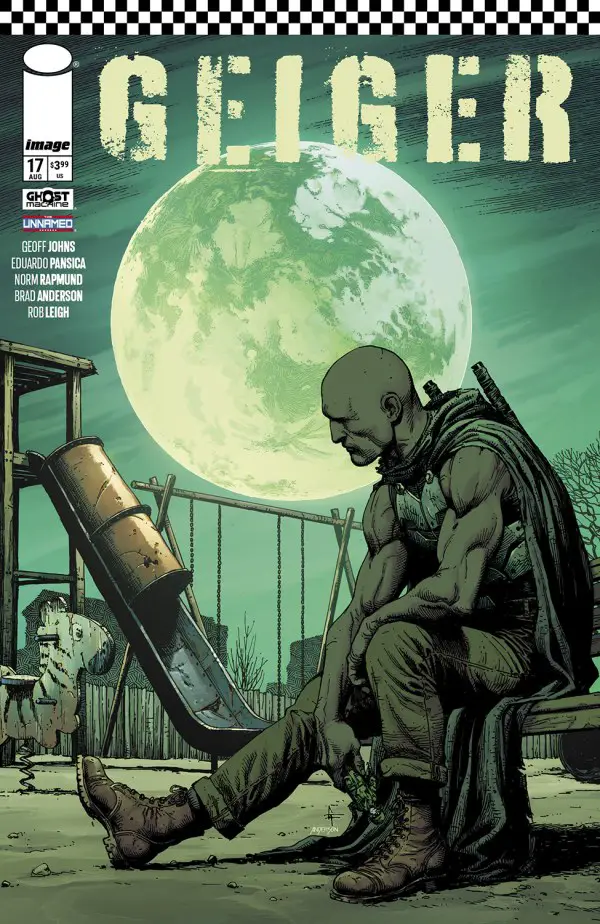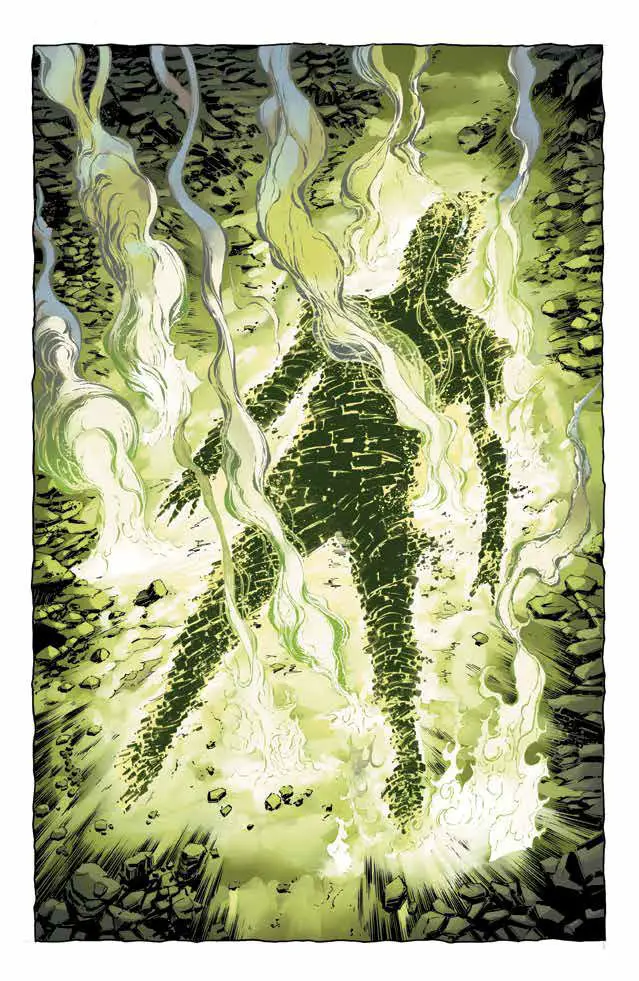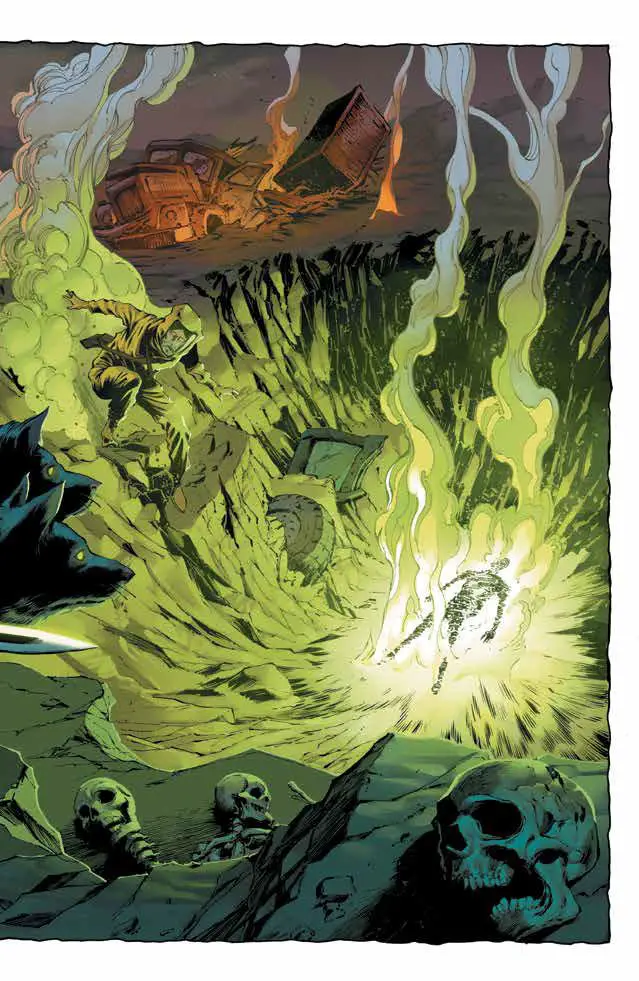Geiger #17, by Image Comics on 8/27/25, finds Tariq Geiger waking up in a remote prison when the warden and inmates believe he’s a member of a notorious gang.
Credits:
- Writer: Geoff Johns
- Artist: Eduardo Pansica, Gary Frank, Norm Rapmund
- Colorist: Robert Nugent, Brad Anderson
- Letterer: Rob Leigh
- Cover Artist: Gary Frank, Brad Anderson (cover A)
- Publisher: Image Comics
- Release Date: August 27, 2025
- Comic Rating: Teen
- Cover Price: $3.99
- Page Count: 22
- Format: Single Issue
Covers:

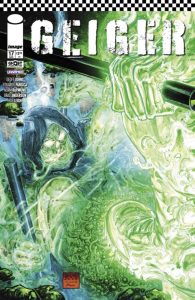
Analysis of GEIGER #17:
First Impressions:
This issue feels like it’s dragging its feet, rehashing familiar territory without much forward momentum. The initial explosion is visually striking, but the narrative quickly devolves into predictable searching and questioning. It is a slow start for a comic that known for explosive action.
Recap:
In Geiger #16, Tariq Geiger’s control over his powers became increasingly unstable after absorbing a massive amount of radiation from a nuclear warhead. Despite a brief reunion with Dr. Andrei Molotov—the designer of his vest and control rods—Geiger struggled to manage his abilities. When the Warlords of Vegas confronted them again, Geiger’s uncontrolled, explosive response left nothing but a human-shaped crater in their wake.
Plot Analysis:
The issue begins immediately after Geiger’s explosive confrontation, leaving behind a human-shaped crater and a radiating green mist. Dr. Molotov, accompanied by Nathan and a two-headed wolf named Barney, surveys the aftermath, questioning if Geiger is dead. Nathan initially fears the worst, but Barney, the two-headed wolf, picks up Geiger’s scent, indicating he might still be alive. Dr. Molotov observes that Geiger’s cells were “drowning in radiation” after the Lewistown explosion, and the atmospheric radiation levels were rising, suggesting Geiger absorbed it all.
Meanwhile, two horse-mounted figures in hazmat suits discover a man, Geiger in his human form, suffering from severe radiation poisoning and blistering skin. They identify him as one of Goldbeard’s men, likely on a recon mission. They decide to cuff him, stabilize him, and bring him back to Warden Wren for interrogation, believing he might hold the key to finding Goldbeard’s treasure. These figures are part of a heavily armored group, also mounted on horses, who appear to be law enforcement or military personnel based on their “POLICE” labeled gear.
Warden Wren interrogates Geiger for the location of Goldbeard’s treasure, without success. Geiger is taken to a prison cell where his inmate explains the history of Goldbeard. Geiger tries to escape the cell with the use of his powers, but he realizes his rods are missing and he isn’t glowing. Suddenly, the inmate jumps Geiger, believing Geiger’s connection to Goldbeard will earn him a release.
The issue ends with a prologue through the eyes of the recovering Junkyard Joe as Nate and Dr. Molotov track Geiger’s journey through his radiation trail.
Story
The narrative immediately drops the reader into the aftermath of a major event, forcing them to catch up. Dialogue is sparse, relying heavily on visual storytelling and internal monologues to convey fear and uncertainty. The pacing of the main story is slow, dedicating significant space to character introductions and world-building information for Goldbeard. The use of a two-headed dog, Barney, to track Geiger is a clever touch, providing a non-human element that still drives the plot. The exposition for Goldbeard is extensive, almost feeling like a data dump rather than integrated storytelling.
Art
Eduardo Pansica (penciler) and Norm Rapmund (inker) handle pages 1-18, creating a detailed and moody post-apocalyptic landscape. Robert Nugent’s color art on these pages contributes significantly to the irradiated atmosphere with pervasive green hues. Gary Frank and Brad Anderson take over art and colors for pages 19-22, maintaining a consistent visual style despite the shift in artists. The depiction of Geiger’s transformation is abstract but effective, using dark panels and glowing effects to convey intensity. The character designs for the horse-mounted figures are solid, showcasing functional but menacing armor.
Characters
Tariq Geiger is presented as a character in deep physical and existential crisis, struggling with his volatile powers. Dr. Molotov is portrayed as a scientist burdened by the consequences of his creations, while Nathan serves as his hopeful but uncertain companion. Goldbeard is introduced as a complex, almost anti-heroic figure, a warlord with a code of honor in a lawless world. The shadowy figure observing from afar remains an enigma, adding a layer of mystery.
Positives
The visual direction of this issue is its strongest asset, crafting a truly desolate and radiation-scarred world that feels authentic and dangerous. The art team effectively uses color and line work to establish a grim, oppressive atmosphere that complements the narrative’s themes of survival and power. The brief, intense sequence of Geiger’s internal struggle, rendered with stark black and glowing green, is a standout moment that powerfully conveys his torment without a single word. The detailed character bio for Goldbeard provides a compelling backstory, giving depth to a key antagonist.
Negatives
The narrative pacing is a significant drawback, particularly the lengthy exposition dump about Goldbeard which grinds the main story to a halt. This information, while relevant, feels poorly integrated and detracts from the immediate tension built in the preceding issues. The dialogue for the first half of the issue is minimal and overly speculative, failing to advance the plot meaningfully. The transition between artists, while visually consistent, subtly contributes to a lack of immediate artistic signature, making the overall art good, but not groundbreaking.
Art Samples:

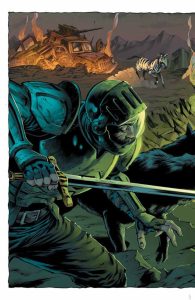
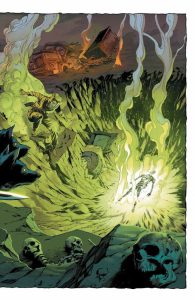
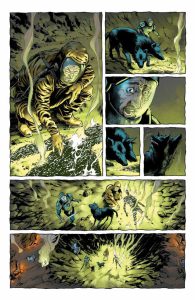
Final Thoughts:
(Click this link 👇 to order this comic)
GEIGER #17 struggles to find its footing after a promising, explosive opening. While the artwork consistently delivers a bleak, compelling wasteland, the narrative frequently bogs down in exposition, leaving the reader waiting for the actual story to unfold. It’s a visually strong issue with a wealth of character lore, but it lacks the dynamic plot progression needed to truly shine.
We hope you found this article interesting. Come back for more reviews, previews, and opinions on comics, and don’t forget to follow us on social media:
If you’re interested in this creator’s works, remember to let your Local Comic Shop know to find more of their work for you. They would appreciate the call, and so would we.
Click here to find your Local Comic Shop: www.ComicShopLocator.com
As an Amazon Associate, we earn revenue from qualifying purchases to help fund this site. Links to Blu-Rays, DVDs, Books, Movies, and more contained in this article are affiliate links. Please consider purchasing if you find something interesting, and thank you for your support.


